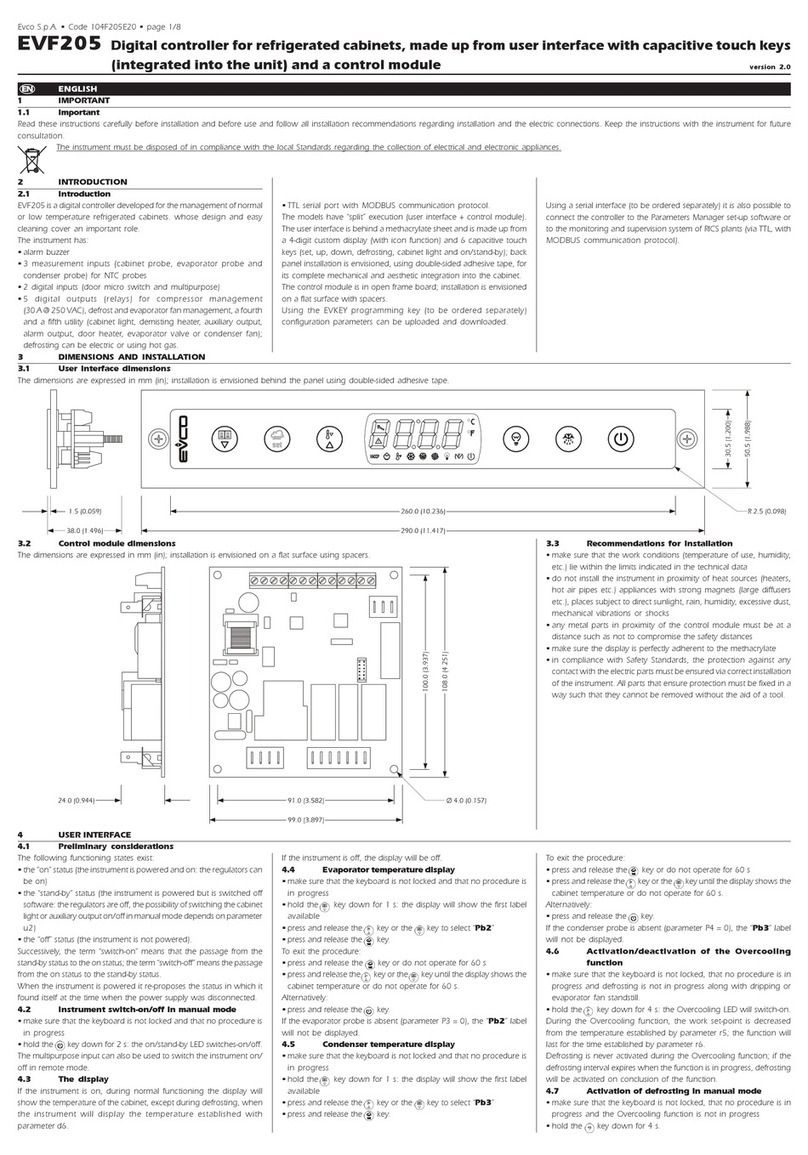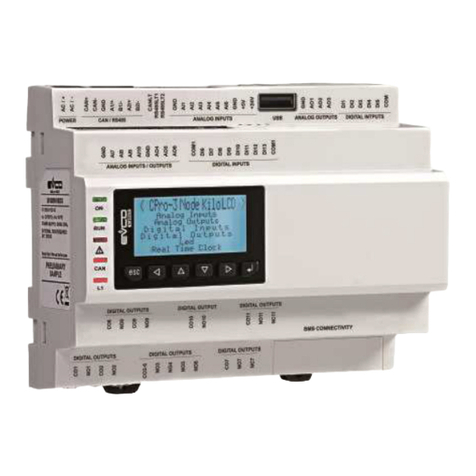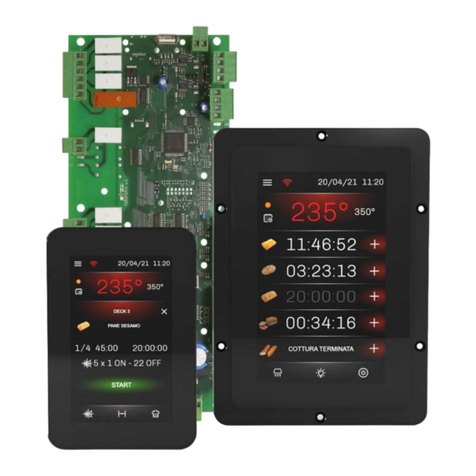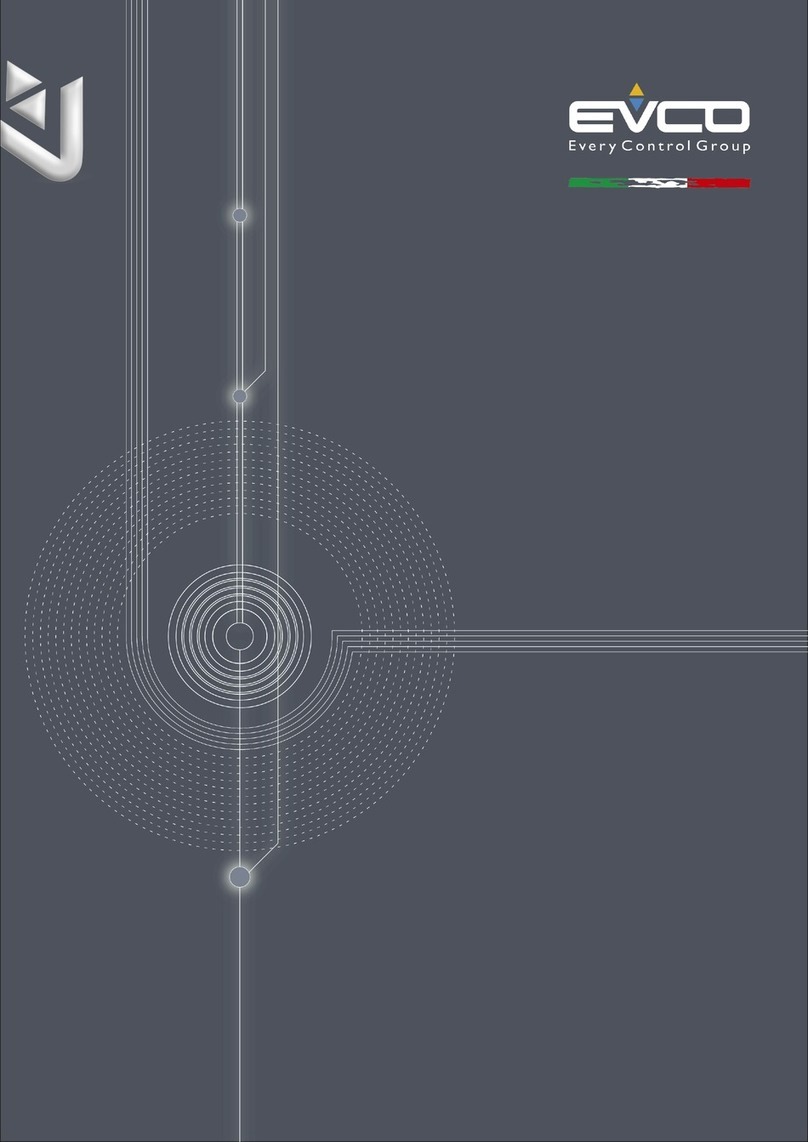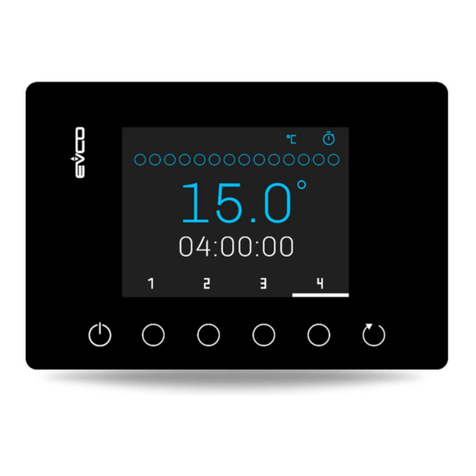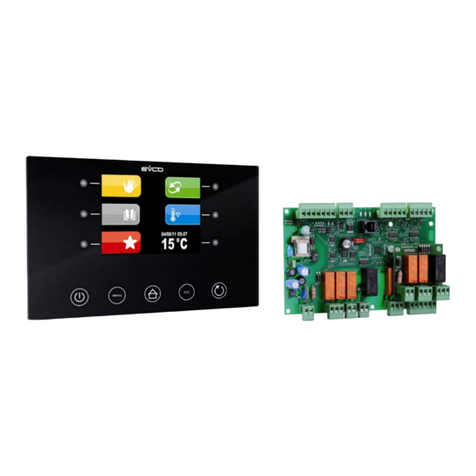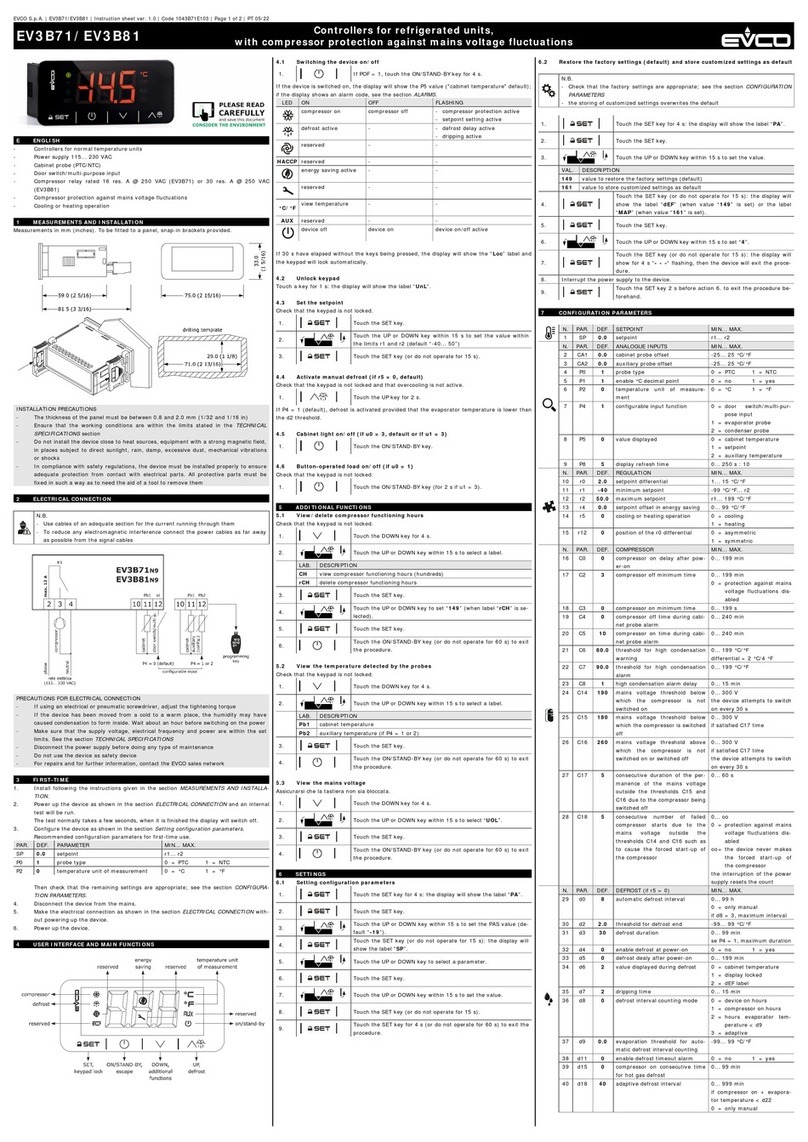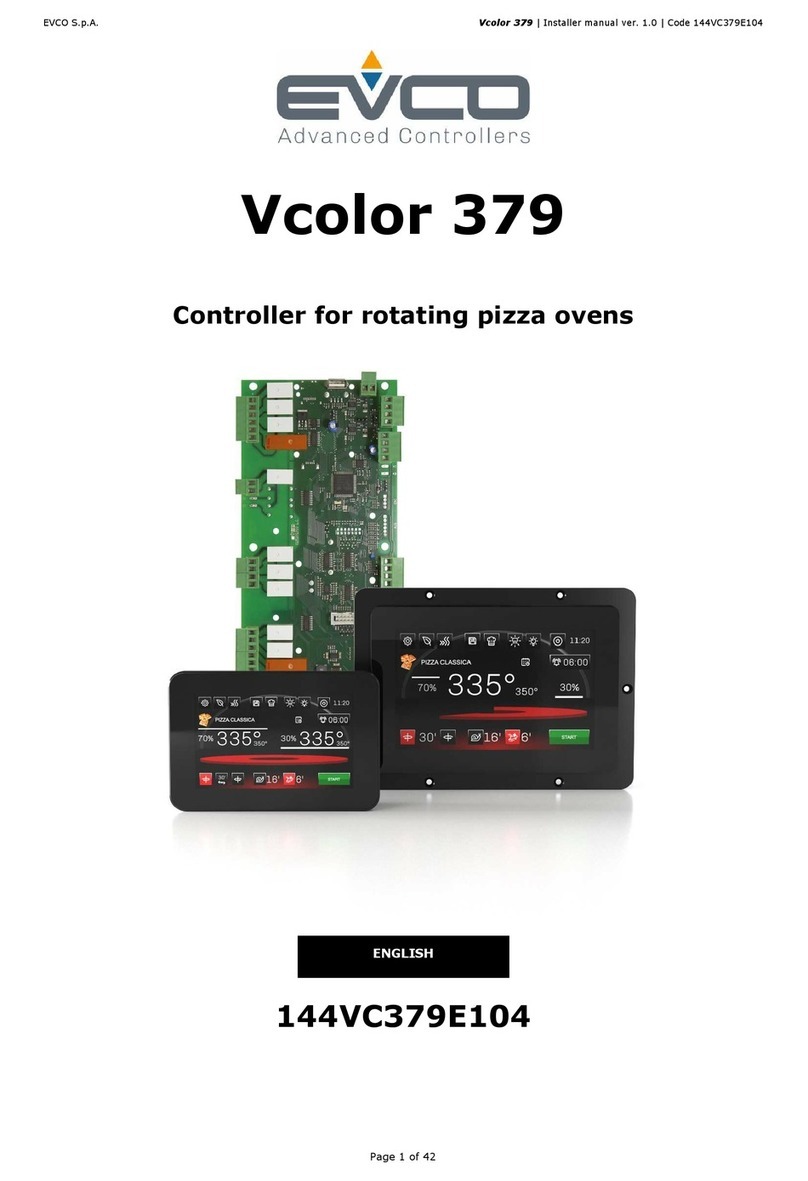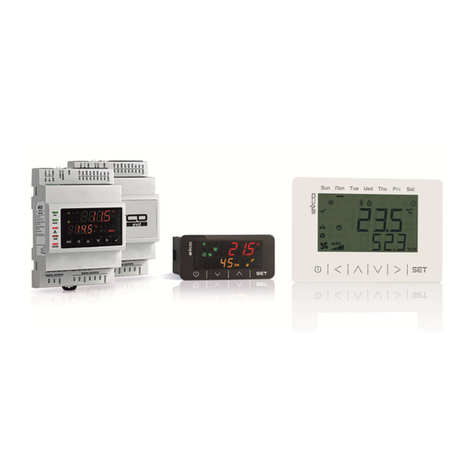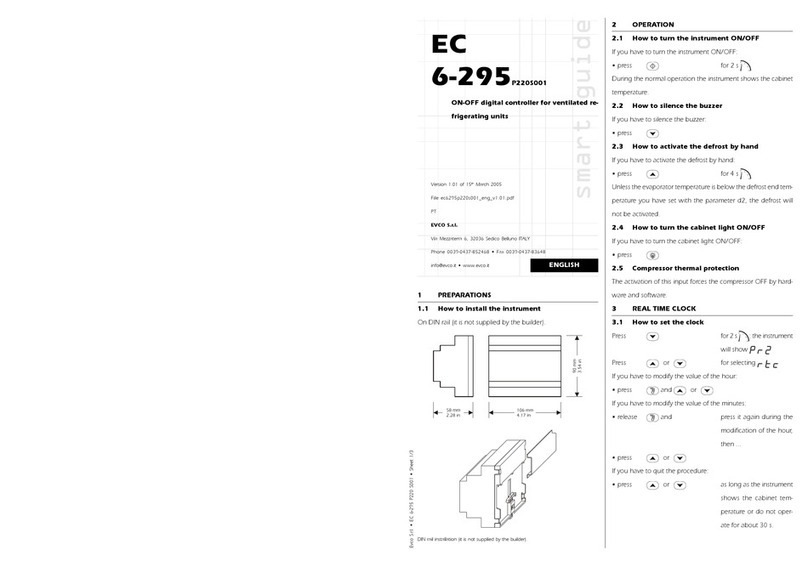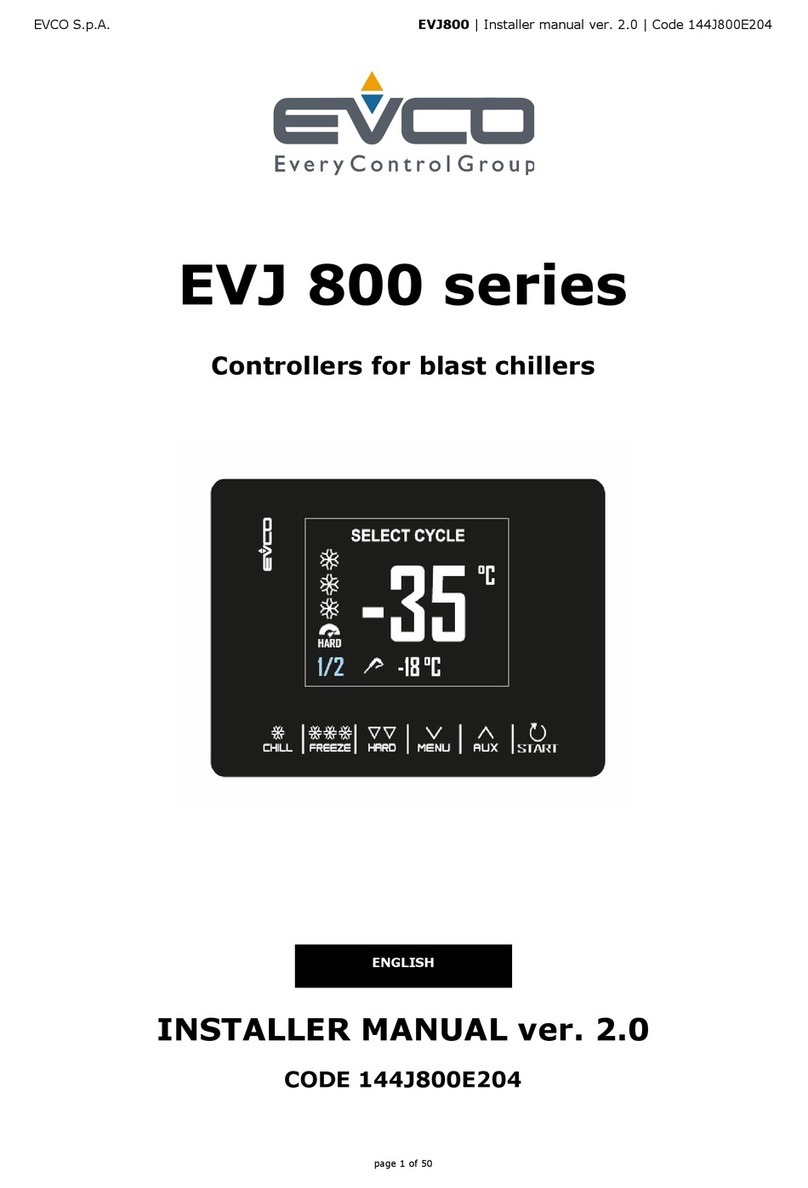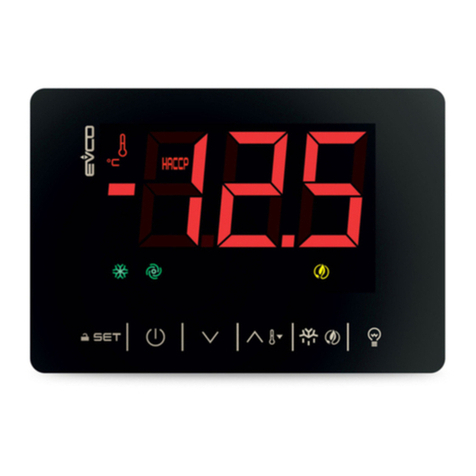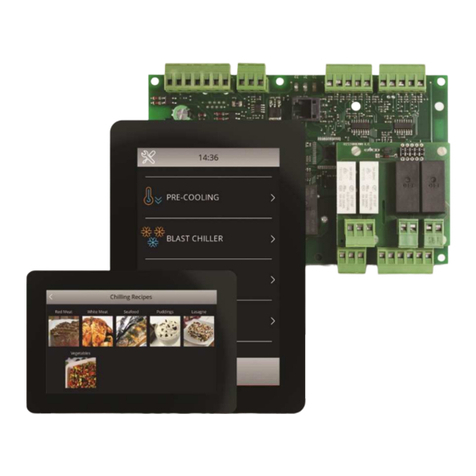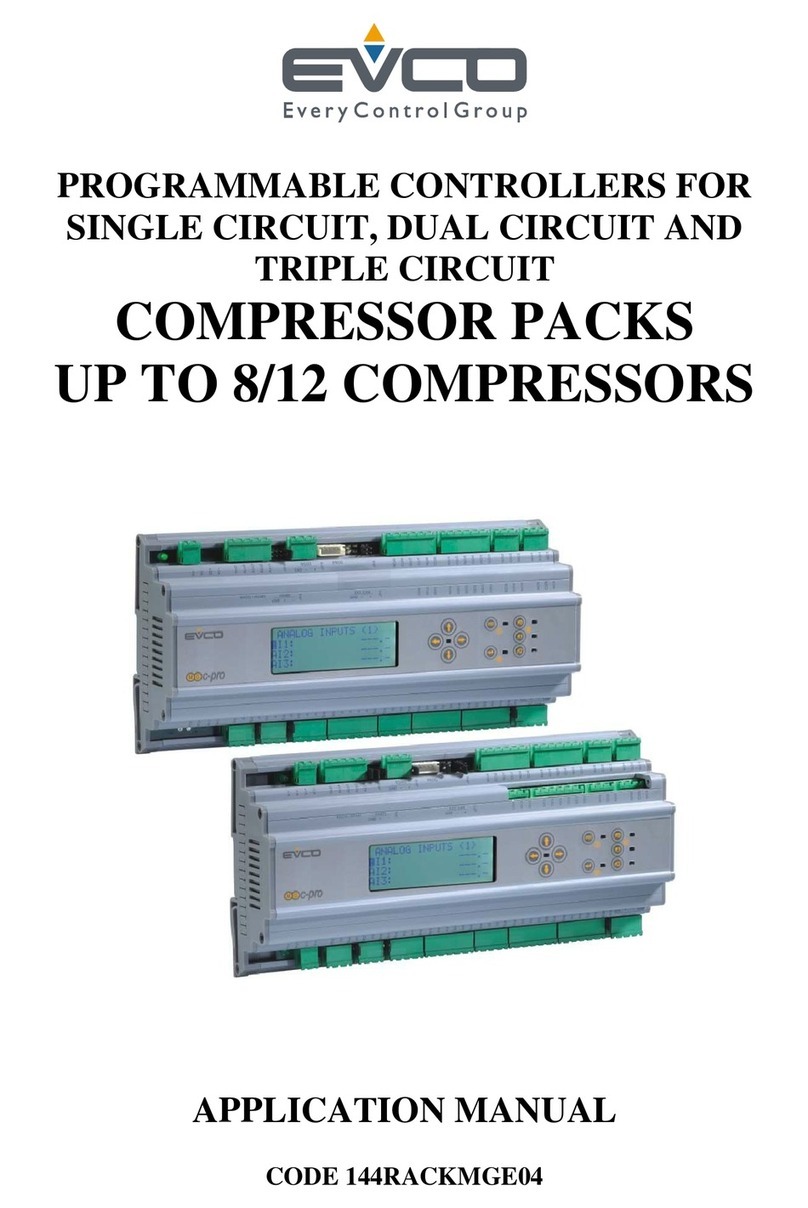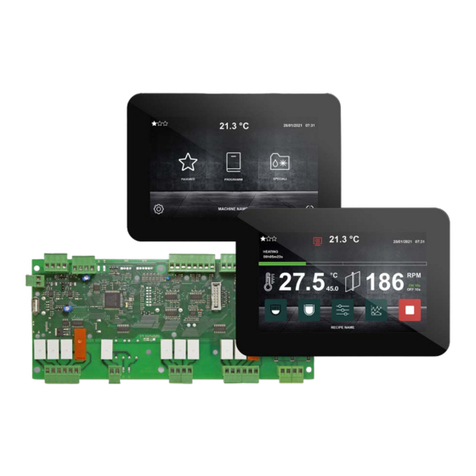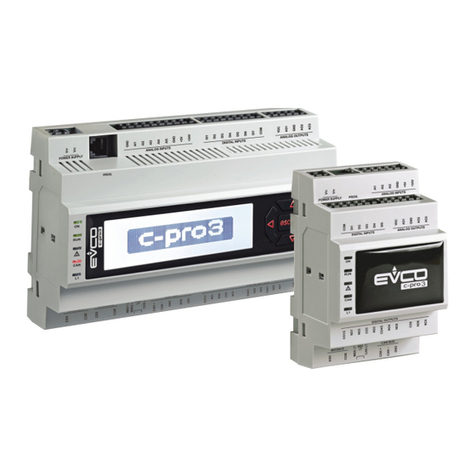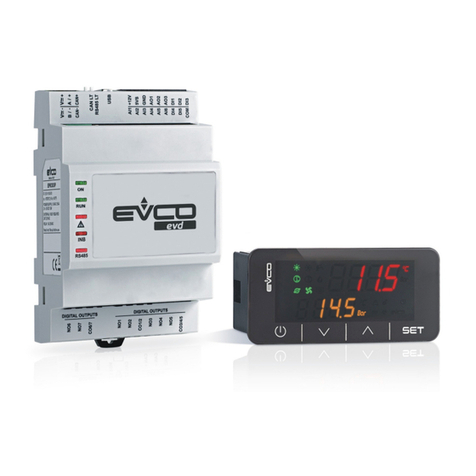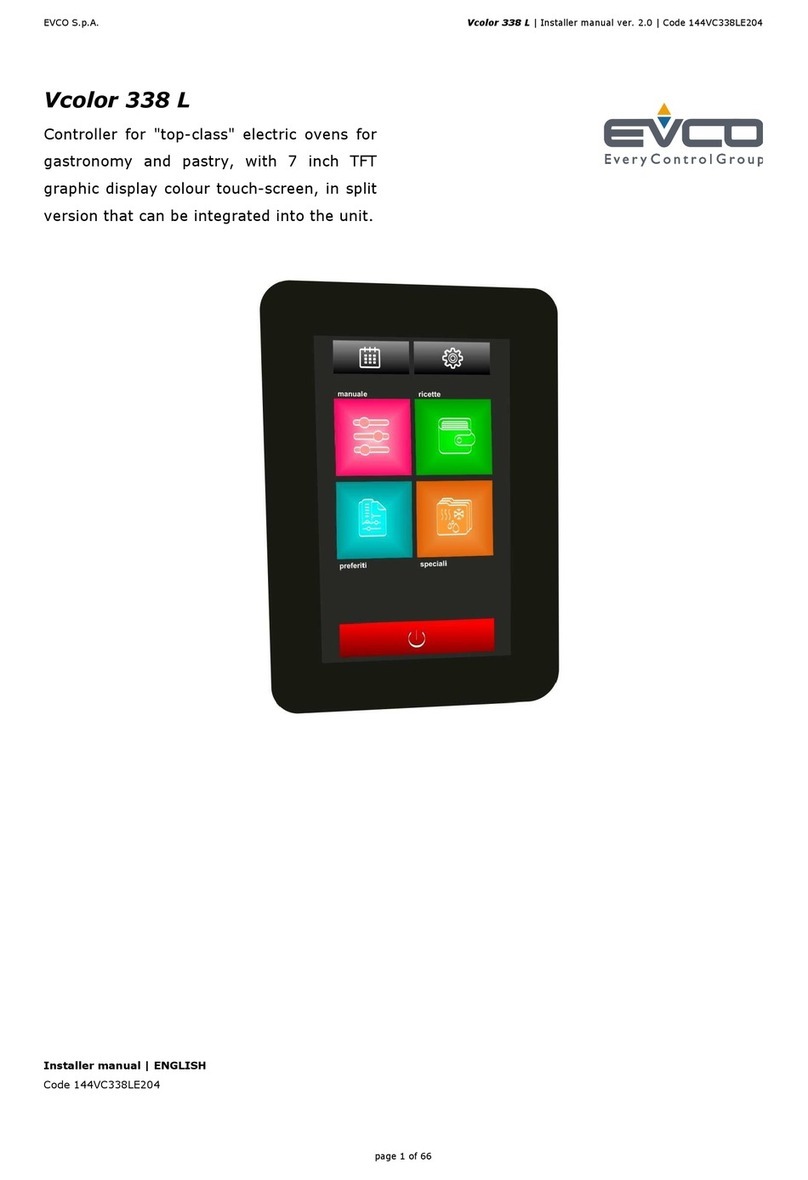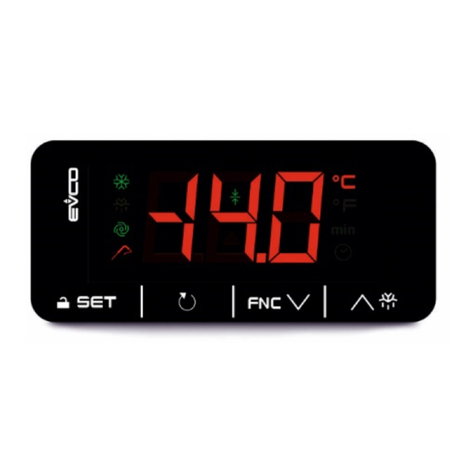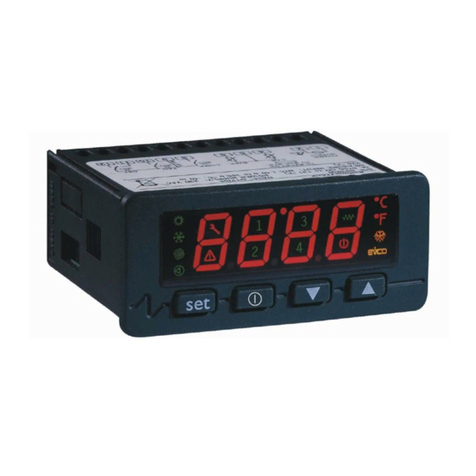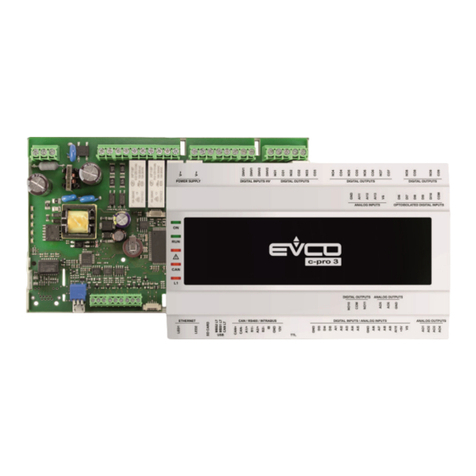
EVCO S.p.A. • Code 104CP3UBA103 • page 1/2
c-pro 3
micro BASIC
Programmable controllers version 1.0
4 SIZE AND INSTALLATION
4.1 Size
4 DIN modules; size in mm (in).
4.2 Installation
On DIN rail 35.0 x 7.5 mm (1.377 x 0.295 in) or 35.0 x 15.0 mm
(1.377 x 0.590 in).
To install
c-pro 3
micro BASIC
operate as shown in the following draw-
ing.
To remove
c-pro 3
micro BASIC
remove possible extractable screw ter-
minal blocks plugged at the bottom first, then operate on the DIN rail
clips with a screwdriver as shown in the following drawing.
To install
c-pro 3
micro BASIC
again press the DIN rail clips to the end
first.
4.3 Additional information for installation
• working conditions (working temperature, humidity, etc.) must be be-
tween the limits indicated in the technical data
• do not install the controller close to heating sources (heaters, hot air
ducts, etc.), devices provided with big magnetos (big speakers, etc.),
locations subject to direct sunlight, rain, humidity, dust, mechanical
vibrations or bumps
• according to the safety legislation, the protection against electrical
parts must be ensured by a correct installation of the controller; the
parts that ensure the protection must be installed so that you can not
remove them if not by using a tool.
5 ELECTRICAL CONNECTION
5.1 Electrical connection
5.2 Meaning of connectors
The following tables show the meaning of the connectors.
DIGITAL OUTPUTS
Digital outputs 6 and 7 (electromechanical relays).
TERM. MEANING
NO6 normally open contact digital output 6
NO7 normally open contact digital output 7
CO6/7 common digital outputs 6 and 7
Digital outputs 1... 5 (electromechanical relays).
TERM. MEANING
NO1 normally open contact digital output 1
NO2 normally open contact digital output 2
CO1/2 common digital outputs 1 and 2
NO4 normally open contact digital output 4
NO5 normally open contact digital output 5
CO3/4/5 common digital outputs 3, 4 and 5
Power supply and CAN port.
TERM. MEANING
V≅+ power supply controller (12 VAC); connect the phase
V≅- power supply controller (12 VAC); connect the neutral
CAN + signal + CAN port
CAN - signal - CAN port
If the controller is supplied in direct current, it will be necessary to re-
spect the polarity of the power supply voltage.
CAN LT
Micro-switch to plug in the termination of the CAN port.
Position micro-switch 2 on position ON to plug in the termination of the
CAN port.
USB
USB OTG port.
Analog inputs, digital inputs and analog outputs.
TERM. MEANING
AI1 analog input 1 (configurable via configuration parameter
for PTC / NTC / Pt 1000 probes / 0-20 mA / 4-20 mA / 0-5 V
ratiometric / 0-10 V transducers)
AI2 analog input 2 (configurable via configuration parameter
for PTC / NTC / Pt 1000 probes / 0-20 mA / 4-20 mA / 0-5 V
ratiometric / 0-10 V transducers)
AI3 analog input 3 (configurable via configuration parameter
for PTC / NTC / Pt 1000 probes / 0-20 mA / 4-20 mA / 0-5 V
ratiometric / 0-10 V transducers)
AI4 analog input 4 (configurable via configuration parameter
for PTC / NTC / Pt 1000 probes)
AI5 analog input 5 (configurable via configuration parameter
for PTC / NTC / Pt 1000 probes)
AI6 analog input 6 (configurable via configuration parameter
for PTC / NTC / Pt 1000 probes)
DI4 digital input 4 (optoisolated, at 24 VAC / DC and at 2 KHz)
DI5 digital input 5 (optoisolated, at 24 VAC / DC and at
50 / 60 Hz)
COM common digital inputs
+12V power supply 0-20 mA / 4-20 mA / 0-10 V transducers
(12 VDC, 120 mA max.)
5VS power supply 0-5 V ratiometric transducers (5 VDC,
60 mA max.)
GB ENGLISH
1 GETTING STARTED
1.1 Important
Read these instructions carefully before installing and using the control-
ler and follow all additional information for installation and electrical
connection; keep these instructions close to the controller for future
consultations.
The controller must be disposed according to the local
legislation about the collection for electrical and electronic
equipment.
2 INTRODUCTION
2.1 Introduction
c-pro 3
micro BASIC
is a family of programmable controllers.
The family is available in the version:
• with 4 + 4 digit custom display (with function icons) and with a 6
buttons (with preset functions) keyboard made of silicone rubber inte-
grated in the controller, hereinafter also called built-in LED versions
• blind (usable for example with an user interface such as
Vgraph
,
Vtouch
,
Vroom
or
Vcolor
) hereinafter also called blind versions.
The controllers have got:
- 6 analog inputs of which 3 configurable via configuration parameter
for PTC / NTC / Pt 1000 probes / 0-20 mA / 4-20 mA / 0-5 V ratiometric
/ 0-10 V transducers and 3 configurable via configuration parameter
for PTC / NTC / Pt 1000 probes
- 5 optoisolated digital inputs at 24 VAC / DC of which 3 at 50 / 60 Hz
and 2 at 2 KHz
- 3 non optoisolated analog outputs of which 2 configurable via con-
figuration parameter for PWM / 0-10 V signal and 1 configurable via
configuration parameter for 0-20 mA / 4-20 mA / 0-10 V signal
- 6 SPST digital outputs (electromechanical relays) rated 3 res. A @
250 VAC
- 2 non optoisolated communication ports of which 1 USB OTG port
(for programming and debugging) and 1 CAN port with CANbus com-
munication protocol.
Through the I/O expansion
c-pro 3 EXP micro
or
c-pro 3 EXP kilo
it is
possible to increase the number of inputs and outputs.
Through the development environment UNI-PRO 3 (to order separately)
it is possible to realize the application software and through the con-
necting cable 0810500018 (2 m, 6,561 ft long) or 0810500020 (0.5 m,
1.640 ft long), to order separately, it is possible to program the control-
ler.
The devices look in case 4 DIN modules.
Installation is in electrical panel, on DIN rail.
Through a common USB peripheral it is possible to make the upload
and the download of the configuration parameters.
For further information please consult the
Hardware manual of
c-pro 3
.
3 DESCRIPTION
3.1 Description
The following table shows the meaning of the parts of the controller.
PART MEANING
1 digital outputs 6 and 7
2 digital outputs 1... 5
3 display and keyboard (not available in the blind versions)
4 analog inputs, digital inputs and analog outputs
5 USB OTG port
6 micro-switch to plug in the termination of the CAN port
7 power supply and CAN port
8 signalling LEDs
GND common analog inputs and analog outputs
AO1 analog output 1 (configurable via configuration parameter
for PWM / 0-10 V signal)
AO2 analog output 2 (configurable via configuration parameter
for PWM / 0-10 V signal)
AO3 analog output 3 (configurable via configuration parameter
for 0-20 mA / 4-20 mA / 0-10 V signal)
DI1 digital input 1 (optoisolated, at 24 VAC / DC and at
50 / 60 Hz)
DI2 digital input 2 (optoisolated, at 24 VAC / DC and at
50 / 60 Hz)
DI3 digital input 3 (optoisolated, at 24 VAC / DC and at 2 KHz)
5.3 Additional information for electrical connection
• do not operate on the terminal blocks with electrical or pneumatic
screwers
• if the controller has been moved from a cold location to a warm one,
the humidity could condense on the inside; wait about an hour be-
fore supplying it
• test the working power supply voltage, working electrical frequency
and working electrical power of the controller; they must correspond
with the local power supply
• connect the controller to the other devices using a twisted pair
• disconnect the local power supply before servicing the controller
• do not use the controller as safety device
• for repairs and information on the controller please contact EVCO
sales network.
6 SIGNALS
6.1 LEDs at the front of the controller
LED MEANING
ON LED power supply
if it is lit, the controller will be supplied
if it is out, the controller will not be supplied
RUN LED run
if it is lit, the application software will be compiled and run-
ning in release modality
if it flashes slowly, the application software will be compiled
and running in debug modality
if it flashes quickly, the application software will be compiled,
running in debug modality and stopped in a breakpoint
if it is out:
- the controller will not be compatible with the application
software
- the controller will not be enabled to work with the special
ABL (Application Block Libraries)
LED system alarm
if it is lit, an alarm system not resettable via software will be
running
if it flashes slowly, a system alarm with automatic reset will
be running
if it flashes quickly, a system alarm with manual reset will be
running
if it is out, no alarm system will be running
CAN LED CANbus communication
if it is lit, the controller will be configured to communicate
via CANbus with another device but the CAN communica-
tion will not have been set up
if it flashes slowly, the CANbus communication will have been
set up but it will not be completely correct
if it flashes quickly, the CANbus communication will have
been set up and will be correct
if it is out, no CANbus communication will be running
L1 LED auxiliary
The operation of this LED can be programmed through the
development environment UNI-PRO 3
7 TECHNICAL DATA
7.1 Technical data
Purpose of control: programmable controller for applications in re-
frigeration, ventilation and air conditioning.
Construction of control: electronic control device to be incorpo-
rated.
Box: self-extinguishing grey.
Size: 71.0 x 135.0 x 60.0 mm (2.795 x 5.314 x 2.362 in); 4 DIN mod-
ules.
Size refers to the controller with all the connectors properly plugged.
Installation: on DIN rail 35.0 x 7.5 mm (1.377 x 0.295 in) or
35.0 x 15.0 mm (1.377 x 0.590 in).
Index of protection: IP20; IP40 the front.
Connections: male Micro-Fit connectors (power supply, inputs, ana-
log outputs and CAN port), male extractable screw terminal blocks pitch
5.0 mm (0.196 in; digital outputs) for conductors up to 2.5 mm² (0.0038
in²), “A” type USB connector (USB port).
The maximum lengths of the connecting cables are the followings:
• power supply controller: 100 m (328 ft)
• analog inputs: 100 m (328 ft); use a shielded cable for the inputs
configured for PTC or Pt 1000 probes in case of lengths over or equal
to 10 m (32.8 ft)
• power supply transducers: 100 m (328 ft)
• digital inputs: 100 m (328 ft)
• PWM analog output: 1 m (3.280 ft)
• 0-20 mA / 4-20 mA / 0-10 V analog outputs: 100 m (328 ft)
• digital outputs: 100 m (328 ft)
• CAN port:
- 1,000 m (3,280 ft) with baud rate 20,000 baud
- 500 m (1,640 ft) with baud rate 50,000 baud
- 250 m (820 ft) with baud rate 125,000 baud
- 50 m (164 ft) with baud rate 500,000 baud.
One suggests using the connecting kit CJAV18 (female extractable screw
terminal blocks pitch 5.0 mm, 0.196 in, to order separately), the con-
necting kit CJAV19 (wired female Micro-Fit connectors, to order sepa-
rately).
To program the controller one suggests to use the connecting cable
0810500018 (2 m, 6 ft long) or 0810500020 (0.5 m, 1.640 ft long), to
order separately.
Working temperature: from -10 to 60 °C (14 to 140 °F) for the
built-in versions, from -20 to 60 °C (-4 to 140 °F) for the blind versions.
Working humidity: from 5 to 95% of relative humidity without con-
densate.
Pollution situation: 2.
Power supply: 12 VAC, 50 / 60 Hz, 20 VA max., supplied from a class
2 circuit.
Protect the power supply with a fuse rated 2A-T 250 V.
Overvoltage category: III.
Analog inputs: 3 analog inputs of which 3 configurable via configu-
ration parameter for PTC / NTC / Pt 1000 probes / 0-20 mA / 4-20 mA /
0-5 V ratiometric / 0-10 V transducers and 3 configurable via configura-
tion parameter for PTC / NTC / Pt 1000 probes.
Power supply 0-5 V ratiometric transducers: 5 VDC, 60 mA max.
Power supply 0-20 mA / 4-20 mA / 0-10 V transducers: 12 VDC, 120 mA
max.
The sum of the maximum current powerable by the two power supply
circuits is 120 mA.
Working range: from -50 to 150 °C (-58 to 302 °F) for PTC probe,
from -50 to 120 °C (-58 to 248 °F) for NTC probe, from -100 to 400 °C
(-148 to 752 °F) for Pt 1000 probe.
Digital inputs: 5 optoisolated digital inputs at 24 VAC / DC of which
3 at 50 / 60 Hz and 2 at 2 KHz.
Resolution: 0.1 °C for PTC / NTC probes, 0.1 °C for Pt 1000 probes,
0.01 mA for 0-20 mA / 4-20 mA transducers, 0.01 V for 0-10 V transduc-
ers.
Analog outputs: 3 non optoisolated outputs:
• 2 outputs configurable via configuration parameter for PWM / 0-10 V
signal
• 1 output configurable via configuration parameter for 0-20 mA /
4-20 mA / 0-10 V signal.
Digital outputs: 6 SPST outputs (electromechanical relays) rated
3 res. A @ 250 VAC.
Type of actions and additional features: 1B.
Communication ports: 2 non optoisolated ports:
• 1 USB OTG port (for programming and debugging)
• 1 CAN port with CANbus communication protocol.
Program memory: 256 KB (FLASH memory).
Data memory: 4 KB (RAM memory).
I ITALIANO
1 IMPORTANTE
1.1 Importante
Leggere attentamente queste istruzioni prima dell’installazione e prima
dell’uso e seguire tutte le avvertenze per l’installazione e per il collega-
mento elettrico; conservare queste istruzioni con il controllore per con-
sultazioni future.
Il controllore deve essere smaltito secondo le normative
locali in merito alla raccolta delle apparecchiature elettriche
ed elettroniche.
2 INTRODUZIONE
2.1 Introduzione
c-pro 3
micro BASIC
è una famiglia di controllori programmabili.
La famiglia è disponibile nella versione:
• con display custom da 4 + 4 digit (con icone funzione) e con tastiera in
gomma siliconica a 6 tasti (con funzioni predefinite) integrati nel con-
trollore, in seguito denominate anche versioni built-in LED
• cieca (utilizzabile per esempio con un terminale utente come
Vgraph
,
Vtouch
,
Vroom
o
Vcolor
), in seguito denominate anche versioni
cieche.
I controllori dispongono di:
- 6 ingressi analogici di cui 3 configurabili via parametro di configura-
zione per sonde PTC / NTC / Pt 1000 / trasduttori 0-20 mA / 4-20 mA
/ 0-5 V raziometrici / 0-10 V e 3 configurabili via parametro di configu-
razione per sonde PTC / NTC / Pt 1000
- 5 ingressi digitali optoisolati a 24 VAC / DC di cui 3 a 50 / 60 Hz e 2
fino a 2 KHz
- 3 uscite analogiche non optoisolate di cui 2 configurabili via parame-
tro di configurazione per segnale di tipo PWM / 0-10 V e 1 configurabile
via parametro di configurazione per segnale di tipo 0-20 mA /
4-20 mA / 0-10 V
- 6 uscite digitali (relè elettromeccanici) da 3 A res. @ 250 VAC di tipo
SPST
- 2 porte di comunicazione non optoisolate di cui 1 di tipo USB OTG
(per la programmazione e il debug) e 1 di tipo CAN con protocollo di
comunicazione CANbus.
Attraverso l’espansione di I/O
c-pro 3 EXP micro
o
c-pro 3 EXP kilo
è
possibile incrementare il numero di ingressi e di uscite.
Attraverso l’ambiente di sviluppo UNI-PRO 3 (da ordinare separatamente)
è possibile realizzare il software applicativo e attraverso il cavo di con-
nessione 0810500018 (di lunghezza 2 m) o 0810500020 (di lunghezza
0,5 m), da ordinare separatamente, è invece possibile programmare il
controllore.
I dispositivi si presentano in contenitore 4 moduli DIN.
L'installazione è prevista in un quadro elettrico, su guida DIN.
Attraverso una comune periferica USB è possibile eseguire l'upload e il
download dei parametri di configurazione.
Per ulteriori informazioni consultare il
Manuale hardware di c-pro 3
.
3 DESCRIZIONE
3.1 Descrizione
La seguente tabella illustra il significato delle parti del controllore.
PARTE SIGNIFICATO
1 uscite digitali 6 e 7
2 uscite digitali 1... 5
3 visualizzatore e tastiera (non disponibile nelle versioni cie-
che)
4 ingressi analogici, ingressi digitali e uscite analogiche
5 porta USB OTG
6 micro-switch per inserire la terminazione della porta CAN
7 alimentazione e porta CAN
8 LED di segnalazione
4 DIMENSIONI E INSTALLAZIONE
4.1 Dimensioni
4 moduli DIN; le dimensioni sono espresse in mm (in).
